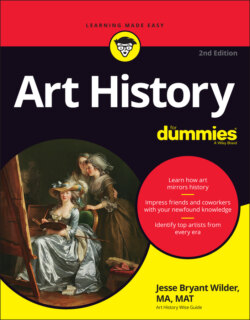Читать книгу Art History For Dummies - Jesse Bryant Wilder - Страница 104
Noting art as history in the Palette of Narmer
ОглавлениеDiscovered in Hierakonpolis, the ancient capital of Upper Egypt, the Palette of Narmer may be the world’s oldest historical document, dating from around 3100 BC. The reliefs on both sides of the green siltstone, as shown in Figure 6-1, tell the story of the unification of Upper and Lower Egypt in horizontal bands, kind of like a comic strip. There’s even some helpful text (like comic-book text bubbles) in hieroglyphics, the picture language of Ancient Egypt. We can’t read every part of the palette, but we can interpret most of it.
CHOLPAN / SHUTTERSTOCK
FIGURE 6-1: The Palette of Narmer chronicles a victory of King Narmer over his enemies.
The Palette of Narmer, the world’s oldest artifact with the name of a ruler inscribed on it, started life as an eye-makeup kit — sort of. Actually, it was a ceremonial makeup palette enlarged to just over two feet high. Egyptians used hand-sized versions to grind pigments that they wore as makeup to protect their eyes from infections and the blazing Egyptian sun. But the Palette of Narmer was way too big for even a pharaoh to haul around in his pocket. The significance of the Palette of Narmer goes way beyond comic strips and makeup kits. Both sides of the palette paint a picture of Egypt’s strength and unity under the divine rule of Narmer. Consider these interpretations of the palette’s purposeful artwork:
Placing Narmer among the gods: The hieroglyph for Narmer’s name — a catfish perched on a chisel — appears at the top on both sides, telling us that Narmer is the main character in the story. Notice that a pair of cow heads in the top strip set off Narmer’s hieroglyph, like bookends. Hathor, the cow goddess, is often viewed as the mother of pharaohs. Placing Narmer’s name between images of Hathor proclaims his divine origin.
Depicting Narmer as leader of ritual: When Moses meets god in the Old Testament, the first thing God tells him to do is take off his shoes. (Exodus 3:5 says, “put off thy shoes from off thy feet, for the place whereon thou standest is holy ground.”) On one side of the palette (refer to the left side of Figure 6-1), Narmer is also shoeless as he clobbers a kneeling enemy. (The victim resembles the two sprawling, naked guys in the bottom band. Apparently, they’ve already been clobbered and are now worm’s meat.) A servant behind Narmer lugs the pharaoh’s sandals. Is there a connection between removing shoes and clobbering somebody? Perhaps it’s because slaughtering defeated enemies was a religious ritual showing that the divine pharaoh was always right. (People always find ways to justify their brutalities.) Also, like Moses, Pharaoh is in the company of a god — in this case, Horus, the hawk-god hovering over him.
Showing victory for Upper Egypt and harmony with the gods: Horus, the god of war and light, is sometimes depicted as a man with a hawk’s head and other times simply as a hawk. Here he’s a hawk with one claw and one human arm with which he de-brains an enemy attached (like a vase) to a bouquet of papyrus plants. (In the process of mummification, the embalmer drained the dead person’s brain through the nose, which is what Horus seems to be doing with that hook in his hand.) The fact that the hawk stands atop papyrus plants, the symbol of Lower Egypt, shows that Lower Egypt has been subdued. Also, Horus’s action parallels the pharaoh’s and indicates that Narmer’s deeds are in harmony with those of the gods.
Revealing Narmer’s status and prestige: On the flipside of the Palette of Narmer (refer to the right side of Figure 6-1), Narmer, identifiable again by his size and by the hieroglyphic nametag next to his head, is also shoeless. Why? He’s probably performing another religious act, inspecting decapitated enemies who have been stacked with their lopped heads between their legs. The standard bearers of a priest and a pharaoh march before him. Their respective heights indicate their ranks.
Denoting Narmer as mighty ruler: On the next lower strip, two snake-necked lionesses face off. Their entwined necks and perfect symmetry may suggest the unification of Upper and Lower Egypt, and that both halves of Egypt are equal. Note that two of the pharaoh’s men restrain the lionesses, implying that the two Egypts need to be governed by a strong hand, Narmer’s. In the bottom band, a bull (possibly the Apis Bull, also a god) tromps Egypt’s enemies, while knocking down a fortress with his tusks. Bulls were often used to depict the might of pharaoh.
